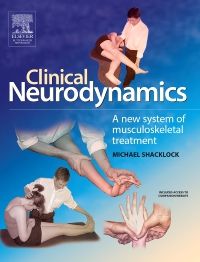A groundbreaking approach to neural mobilization, this one-of-a-kind resource draws on the established Maitland movement diagram to present a completely new system for mobilization of the neural and musculoskeletal systems. The text guides readers through the complex subject of neurodynamics and the basic mechanisms in movement of the nervous system, systematically linking causal mechanisms to diagnosis and treatment of pain and common musculoskeletal problems. This new progressional method is ideal for diagnosis and treatment of musculoskeletal disorders with neural involvement such as spinal and peripheral (extremity) disorders, the nerve root, dura and peripheral nerve.
Key Features
- Unique approach applies and modifies Maitland techniques to neural mobilization, refining and improving practical skills for clinical physical therapists.
- A new movement diagram applies Maitland's established movement diagram to the nervous system and enables professionals to integrate musculoskeletal and neural mechanisms.
- New diagnostic categories of specific dysfunctions, focused on evidence-based research, are presented.
- Various treatment techniques for each diagnostic category are discussed. and applied to specific clinical problems such as neck pain, headache, tennis elbow, carpal tunnel syndrome, and low back pain.
- Summary and key points are indicated with symbols throughout the book.
- An accompanying CD-ROM provides real-time images of nerves moving and shows dynamic abnormalities of nerves.
- Illustrations show how neuromusculoskeletal problems develop in a way that uniquely links musculoskeletal and neural functions.
- Clinical case histories illustrate the key points related to scientific and clinical applications.
Author Information
By Michael Shacklock, FACP, MAppSc, DipPhysio, Director, City Physiotherapy and Sports Injury Clinic, Adelaide, Australia and Fellow of the Australian College of Physiotherapists
1. General Neurodynamics2. Specific Neurodynamics3. General Neuropathodynamics4. Diagnosis of specific dysfunctions5. Diagnosis with Neurodynamic Tests6. Planning the Physical Examination7. Standard Neurodynamic Testing8. Method of treatment: systematic progression9. Cervical Spine10. Upper limb11. Lumbar Spine12. Lower Limb
GlossaryIndex
Shacklock's book is a wonderful gift as well as a triumph of clinical reasoning and careful research. Examination of the nervous system typically does not extend beyond a search for neurologic signs and the most rudimentary mobility tests of major portions of that organ. Given what we've learned during the course of the neurobiologic revolution, this seems wholly inadequate. Shacklock describes specific testing of virtually every portion of the peripheral nervous system and reasonably asserts that this approach is necessary to complete the diagnostic picture of our patients with painful problems that display no relevant evidence of pathology. That is, something that requires healing or repair. My own students assure me that these patients comprise the majority of those with a primary complaint of pain. To me, this knowledge fills a hole in therapy through which countless patients have fallen. The author fills this book instead with a wonderful exposition of the deep model of neurobiology as it is currently understood and relevant to the clinician seeing patients in pain. He then tackles the nuts and bolts of testing and treatment, liberally providing all he can about the intricate nature of nervous biomechanics, paying careful attention to what is known of the bodily interface and the nature of its sensitivity. Every possible test is carefully illustrated and many pages are peppered with this master clinician's personal experience. For the sural nerve alone there are three pages devoted to its place in symptomotology, the intricate nature of its testing and specific thoughts about its treatment along with three clear and concise photographs. What more could a clinician seeking direction ask for? Oh yes, a CD-ROM provided with the book further illustrates his approach to the median, posterior tibial and ulnar nerves as well as the brachial plexus at the thoracic outlet. This is a wonderful addition to the text.Barrett L. Dorko P.T.














